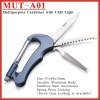
Combination Lock Aluminum Carabiner 1.Size:97x48x14mm 2.Made of Aluminum 3.Safety Twistlock 4.Stainless Steel Accessory
Fancy aluminum combination lock carabiner hooks
with twist-lock
screw-lock is available
Item size: 9.7x4.8x1.4cm
Aluminum / Alumina is available.
tools including: knife, wood saw, bottle opener with nail file, LED light
Physical properties from Vikipedia
ShapeCarabiners come in four characteristic shapes:
Oval: Symmetric. Most basic and utilitarian, also the least expensive. Smooth regular curves are gentle on equipment and allow easy repositioning of loads. Their greatest disadvantage is that a load is shared equally on both the strong solid spine and the weaker gated axis. D: Asymmetric shape transfers the majority of their load onto the spine, the carabiner's strongest axis. Slightly more expensive. Offset-D: Variant of a D with a greater assymmetry, allowing for a wider gate opening. More expensive yet. Pear/HMS: Specialized oversized offset-D's used in belaying. Most expensive and heaviest carabiner. Locking mechanisms Clockwise from top left: D-shaped wire gate, D-shaped straight gate, Oval straight gate, Pear-shaped auto-locker, D-shaped screw-locker. Center is a standard carabiner rating.There are two broad categories of carabiner, locking and non-locking.
[edit] Non-lockingNon-locking carabiners have a sprung swinging gate that accepts a rope, webbing sling, or other hardware. Rock climbers frequently connect two non-locking carabiners with a short length of nylon web to create a quickdraw.
Three gate types are common:
Straight gate: The most utilitarian, and hence most popular. Bent gate: Curved gates allow for easier clipping in and out in special situations, such as connecting a rope to a quickdraw. Gate strength remains on a par with straight-gate carabiners. Wire gate: The lightest type, with a strength roughly equal to the others, allowing more to be carried for a given weight. Wire gates are less prone to icing up than solid gates, an advantage in Alpine mountaineering and ice climbing. The reduced gate mass makes their wire bales less prone to 'gate flutter,' a dangerous condition created by irregular impact forces generated by the climbing rope or contact with hard surfaces in a fall which momentarily opens the gate (and both lowers the breaking strength of the carabiner when open and potentially allows the rope to escape). LockingLocking carabiners have the same general shape as non-locking carabiners but have an additional sleeve securing the gate. These sleeves may be either threaded ("screw-lock") or spring-loaded ("twist-lock").
Screw-lock: Have a threaded sleeve over the gate which must be engaged and disengaged manually. They have fewer moving parts than spring-loaded mechanisms, are less prone to malfunctioning due to contamination or component fatigue, easier to employ one-handed. They, however, require more total effort and are more time-consuming than twist-lock. Twist-lock: Have a security sleeve which must be manually rotated to disengage, but which springs closed automatically upon release. They offer the advantage of re-engaging without additional user input, but being spring-loaded are prone to both spring fatigue and their more complex mechanisms becoming balky from dirt, ice, or other contamination. They are also difficult to engage one-handed and with gloves on.(MUT-A01) Combination Lock Carabiner Hook with LED Light


